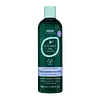What's inside
What's inside
 Key Ingredients
Key Ingredients

 Benefits
Benefits

 Concerns
Concerns

 Ingredients Side-by-side
Ingredients Side-by-side

Melaleuca Alternifolia Leaf Water
AntimicrobialMentha Piperita Callus Lysate
AntioxidantEucalyptus Globulus Leaf
Skin ConditioningRosmarinus Officinalis Leaf
Skin ConditioningUrtica Dioica
Thymus Vulgaris Oil
MaskingBetula Ermanii Bark
Skin ConditioningAnthemis Nobilis Flower Extract
MaskingSalvia Sclarea Oil
MaskingLavandula Angustifolia Extract
Skin ConditioningTussilago Farfara Callus Culture Extract
Skin ConditioningAchillea Millefolium Oil
CleansingMalva Sylvestris Seed
Skin ConditioningEquisetum Arvense Juice
Skin ConditioningGlycine Soja Protein
EmulsifyingSodium C12-14 Olefin Sulfonate
CleansingCocamidopropyl Betaine
CleansingTocopherol
AntioxidantCitric Acid
BufferingPhenoxyethanol
PreservativeSodium Chloride
MaskingCitrus Grandis
Melaleuca Alternifolia Leaf Water, Mentha Piperita Callus Lysate, Eucalyptus Globulus Leaf, Rosmarinus Officinalis Leaf, Urtica Dioica, Thymus Vulgaris Oil, Betula Ermanii Bark, Anthemis Nobilis Flower Extract, Salvia Sclarea Oil, Lavandula Angustifolia Extract, Tussilago Farfara Callus Culture Extract, Achillea Millefolium Oil, Malva Sylvestris Seed, Equisetum Arvense Juice, Glycine Soja Protein, Sodium C12-14 Olefin Sulfonate, Cocamidopropyl Betaine, Tocopherol, Citric Acid, Phenoxyethanol, Sodium Chloride, Citrus Grandis
Water
Skin ConditioningSodium C14-16 Olefin Sulfonate
CleansingCocamide Mea
EmulsifyingCocamidopropyl Betaine
CleansingGlycerin
HumectantGlycol Distearate
EmollientMelaleuca Alternifolia Leaf Oil
AntioxidantRosmarinus Officinalis Leaf Oil
MaskingMenthol
MaskingPanthenol
Skin ConditioningPolyquaternium-68
Polyquaternium-7
Ethylhexylglycerin
Skin ConditioningPEG-150 Distearate
EmulsifyingGuar Hydroxypropyltrimonium Chloride
Skin ConditioningSodium Hydroxide
BufferingPhenoxyethanol
PreservativeHydroxypropyl Methylcellulose
Emulsion StabilisingSodium Benzoate
MaskingMagnesium Nitrate
Sodium Chloride
MaskingMethylisothiazolinone
PreservativeMethylchloroisothiazolinone
PreservativeCitric Acid
BufferingMagnesium Chloride
Parfum
MaskingLimonene
PerfumingLinalool
PerfumingWater, Sodium C14-16 Olefin Sulfonate, Cocamide Mea, Cocamidopropyl Betaine, Glycerin, Glycol Distearate, Melaleuca Alternifolia Leaf Oil, Rosmarinus Officinalis Leaf Oil, Menthol, Panthenol, Polyquaternium-68, Polyquaternium-7, Ethylhexylglycerin, PEG-150 Distearate, Guar Hydroxypropyltrimonium Chloride, Sodium Hydroxide, Phenoxyethanol, Hydroxypropyl Methylcellulose, Sodium Benzoate, Magnesium Nitrate, Sodium Chloride, Methylisothiazolinone, Methylchloroisothiazolinone, Citric Acid, Magnesium Chloride, Parfum, Limonene, Linalool
 Reviews
Reviews

Alternatives
Ingredients Explained
These ingredients are found in both products.
Ingredients higher up in an ingredient list are typically present in a larger amount.
Citric Acid is an alpha hydroxy acid (AHA) naturally found in citrus fruits like oranges, lemons, and limes.
Like other AHAs, citric acid can exfoliate skin by breaking down the bonds that hold dead skin cells together. This helps reveal smoother and brighter skin underneath.
However, this exfoliating effect only happens at high concentrations (20%) which can be hard to find in cosmetic products.
Due to this, citric acid is usually included in small amounts as a pH adjuster. This helps keep products slightly more acidic and compatible with skin's natural pH.
In skincare formulas, citric acid can:
While it can provide some skin benefits, research shows lactic acid and glycolic acid are generally more effective and less irritating exfoliants.
Most citric acid used in skincare today is made by fermenting sugars (usually from molasses). This synthetic version is identical to the natural citrus form but easier to stabilize and use in formulations.
Read more about some other popular AHA's here:
Learn more about Citric AcidCocamidopropyl Betaine is a fatty acid created by mixing similar compounds in coconut oil and dimethylaminopropylamine, a compound with two amino groups.
This ingredient is a surfactant and cleanser. It helps gather the dirt, pollutants, and other impurities in your skin to be washed away. It also helps thicken a product and make the texture more creamy.
Being created from coconut oil means Cocamidopropyl Betaine is hydrating for the skin.
While Cocamidopropyl Betaine was believed to be an allergen, a study from 2012 disproved this. It found two compounds in unpure Cocamidopropyl Betaine to be the irritants: aminoamide and 3-dimethylaminopropylamine. High-grade and pure Cocamidopropyl Betaine did not induce allergic reactions during this study.
Learn more about Cocamidopropyl BetainePhenoxyethanol is a preservative that has germicide, antimicrobial, and aromatic properties. Studies show that phenoxyethanol can prevent microbial growth. By itself, it has a scent that is similar to that of a rose.
It's often used in formulations along with Caprylyl Glycol to preserve the shelf life of products.
Chances are, you eat sodium chloride every day. Sodium Chloride is also known as table salt.
This ingredient has many purposes in skincare: thickener, emulsifier, and exfoliator.
You'll most likely find this ingredient in cleansers where it is used to create a gel-like texture. As an emulsifier, it also prevents ingredients from separating.
There is much debate on whether this ingredient is comedogenic. The short answer - comedogenic ratings don't tell the whole story. Learn more about comegodenic ratings here.
The concensus about this ingredient causing acne seems to be divided. Research is needed to understand if this ingredient does cause acne.
Scrubs may use salt as the primary exfoliating ingredient.
Learn more about Sodium Chloride